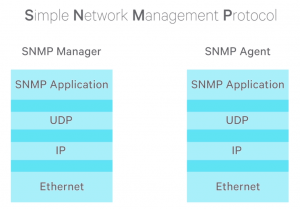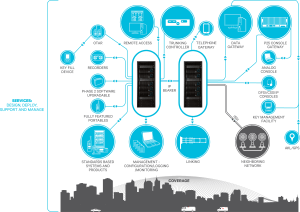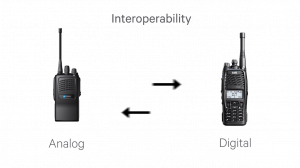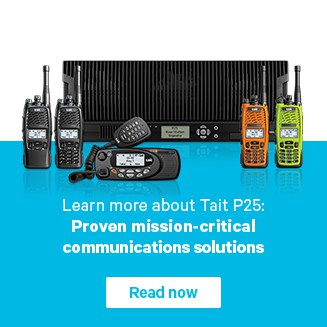Introduction to P25
P25 Network Architecture
P25 Gateways
P25 Network Gateways
P25 networks have standard interfaces defined, allowing different subsystems to connect together, effectively acting as gateways between different parts of the system. Dispatch systems connect to conventional P25 networks using a protocol called the Digital Fixed Station Interface, or DFSI. This permits both voice and control of the repeater.
The DFSI interfaces voice to and from the repeater, and also allows for control over repeater equipment. In larger networks, a group of repeaters can be controlled using the same DFSI interface. Dispatch systems connect to trunked networks using a different protocol, CSSI, the Console Sub-System Interface.
Instead of the dispatcher connecting to a repeater, the dispatcher selects a group that they wish to communicate with and the trunking system sets up a call to that group. The console interfaces allow encrypted communication from the dispatcher out to the radio units, and also support features such as ANI (or Automatic Number Identification), status messaging, emergency alerts, along with many other features.
Voice recorders also offer an interface to a system using the CSSI or DFSI protocol.
The P25 standard also allows for phone calls between radio users and the PSTN (Public Switch Telephone Network) or a PABX (Private Automated Branch Exchange). Many systems have a gateway that allow radio users to make these PABX and PSTN calls.
P25 systems can support IP packet data, meaning data applications can talk to subscribers (mobiles and portables) via an IP address. IP packet data allows P25 networks to support a large range of data applications.
There are several standardized applications, such as data or GPS location services. However, because the transport mechanism uses IP data, many proprietary applications can also be custom-made. Many P25 digital radio systems also include analog gateways.
These allow digital radio channels to interface to legacy analog dispatch equipment or analog channels for interoperability. Some of these gateways even translate analog signaling protocols, like MDC 1200 into their P25 equivalent. Because P25 systems are typically IP-connected, standard IP protocols for fault management can be used.
Many P25 radio networks can interface to existing SNMP management systems.

P25 Telephone Gateways
Telephone calls are an optional feature of P25 trunked networks. In many public safety networks, this feature is not required as the dispatcher can patch a phone call through when needed. The telephone gateway also transcodes the audio between the analog audio in the phone systems and the P25 digital voice on the radio network.
In some commercial systems, such as at oil refineries, the dialing of phone numbers may be required for safety reasons, as cellular phones might not be permitted on the site. For those reasons, some networks do allow radio subscribers to dial phone numbers. The P25 standard includes a protocol to transport the dialed digits from a radio to a telephone gateway.
This gateway then validates if that number is permitted, and if so, sets up a call, and transcodes the audio between the analog on the telephone network, and the P25 digital audio on the radio network.
 Radio Academy
Radio Academy







